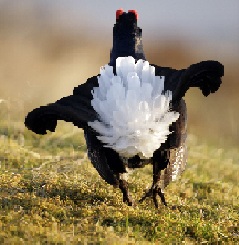Hello again!
Well it’s been a busy winter even with the snow and ice. I was in the office or doing ID work for some of the time, then it was straight back out onto the reserve to do some felling and some ATV work and also plotting out where the new trees have been planted on Corrimony.
Scots pine Pinus sylvestris, downy birch Betula pubescens, juniper Juniperis cummunis, rowan Sorbus aucuparia and my favourite silver birch Betula pendula are continuing to be planted while the beautiful but spiny sitka spruce Picea sitchensis and lodgepole pine Pinus contorta from north America and Japanese and European larches (Larix spp.) are removed.
The latter are the main non natives on the reserve, but there are others. I’m feeling a lot happier identifying trees now. I have an excuse for any misidentifications – I am a zoologist. From the office work, I have submitted my invertebrate data to the Highland Biological Recording Group and after some misspellings on my part, I found I had three exciting fly species that have no or few records in the Highlands. Tipula pabulina (a cranefly) had only three records, Thricops diaphanous had one record and Hydrotaea meteorica had no previous records. These houseflies and craneflies may seem insignificant, but apart from flies being generally amazing the ability to look at the distribution of species over time is important for climate change studies, among others. With the snow finally starting to melt, the invertebrates will be active again!
Once we know the total area the trees cover and identify any new areas to potentially be planted we can feed that information back into the management plan and hopefully continue to increase the quality and quantity of pinewood habitat. On the subject of habitat, it has been too wet and/or windy to burn the heather thus far this year – this is a management tool to vary the age of the heather and thus provide better habitat, particularly for black grouse. I have instead been using a flail mower with the ATV which, if I’m honest, is a hundred times more terrifying than using a chainsaw. As soon as I was left to my own devices to go around a corner, I was stuck. Instead of becoming stuck in a bog, which could mean a two hour waste of time trying to get the thing out with another vehicle, I decided to avoid it by driving up a small hill. This, as I immediately discovered, was not a good idea, with one wheel spinning ineffectually and the trailer jammed into the ground.
Poor Simon had to help me out as I’m not the strongest person in the world but it’s a lesson learned for next time. On the course they basically tell you to avoid any lumps and bumps but as anyone who has been walking in the uplands will testify, the ground is essentially a series of lumps and bumps with a minimum height of around a 1ft and a maximum height of 4409ft, also known as the height of Ben Nevis. One of the great things about our reserve is that even though I’m getting to know it much better, there is always a new and special place to discover.

The grouse are starting to lek again but as there are only a few of them at this time of year I won’t talk about that until survey season. In a couple of months I will be up at dawn (eek!) to help with black grouse surveys, and black grouse safaris where visitors come to see the grouse and have a cup of tea – magic. I will also be countinuing the caterpillar project with a renewed resolve and a (hopefully) better method and longer season in which to do it.
Gwen Potter – Upland Invertebrates Apprentice
